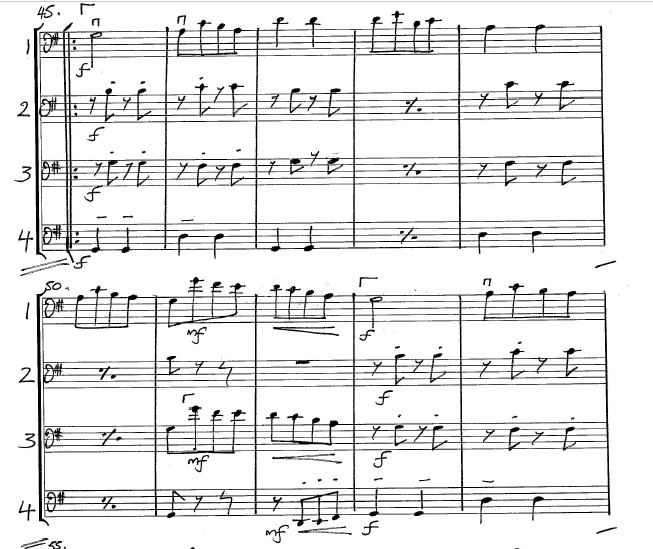OFFENBACH – Infernal Galop (the ‘Can-Can’ Melody) – EASY CELLO QUARTET or for LARGER CELLO ENSEMBLE
- June 30, 2018
- 0 comments
- daib0

3,00€
Available in download/s with price: €3.00
The order is possible by credit card (minimum purchase €4.00) or by PayPal (minimum purchase €4.50)
There are generous discounts for larger orders (see information in the right column)
Please try not to enter more than a single copy of each work (with the quantity set to “1“, you already have 4 opportunities to download the requested PDFs, during a period of 7 days)
In each check-out the web shop can also include up to THREE free products together with your order (indicated with a price of €0.00) at your free choice!
In general, the most detailed descriptive information about the music offered is found in the English version of the website.
Enjoy the music!
Description
Johnstone Creations – Jacques OFFENBACH – the ‘Can-Can’ Melody (Infernal Galop), from Orphée aux Enfers (Orpheus in the Underworld) produced in four parts as a cello quartet. Also very effective for larger cello ensemble right up to a grand cello orchestra. Also very useful for teachers for use in the Cello class, cello courses and workshops etc.
Download Contents or Instructions:
PDF 1 – All individual cello parts (13 pages in all)
PDF 2 – General Score (9 pages in all)
The tempo indication is – Allegro assai
General difficulty of the music – other Information:
Cellists note: EASY. In no place does any part go beyond fourth position and the ‘A’ octave harmonic. All parts are active and all share the melodic importance, making it a true ‘quartet’. However, this arrangement is also very apt for more senior players, even if rather easy to practice up!
Historical note: The can-can (or cancan as in the original French) is a high-energy, physically demanding dance that became a popular music hall dance in the 1840s, continuing in popularity in French cabaret to this day. Originally danced by both sexes, it is now traditionally associated with a chorus line of female dancers. The main features of the dance are the vigorous manipulation of skirts and petticoats, along with high kicks, splits, and cartwheels.
The cancan is believed to have evolved from the final figure in the quadrille, which is a social dance by four couples. The exact origin of the dance is obscure, but the steps may have been inspired by a popular entertainer of the 1820s, Charles Mazurier, well known for his acrobatics, including the grand écart or jump splits – both popular features of the cancan. The dance was considered scandalous, and for a while, there were attempts to repress it. The early cancan dancers were probably prostitutes, but by the 1890s, it was possible to earn a living as a full-time dancer and stars such as La Goulue and Jane Avril emerged, who were highly paid for their appearances at the Moulin Rouge and elsewhere.
Many composers have written music for (see below at the end!) the cancan. The most famous music is French composer Jacques Offenbach’s Galop Infernal in his operetta Orphée aux Enfers (Orpheus in the Underworld).The work, first performed in 1858, is said to be the first classical full-length operetta. Offenbach’s earlier operettas were small-scale one-act works, since the law in France did not allow full-length works of certain genres. The first performance of the two-act, opéra bouffe version took place at the Théâtre des Bouffes-Parisiens in Paris on 21 October 1858 and ran for an initial 228 performances. It then returned to the stage a few weeks later, after the cast had been given a rest. Orpheus was not only longer, but more musically adventurous than Offenbach’s earlier pieces. Titled by Offenbach as the “Infernal Galop” from Act 2, Scene 2, the piece is famous outside classical circles as simply the music for the “can-can” to the extent that the tune is widely, but erroneously, called “can-can”.
Any known possible links of this music (audio, video, article etc.):
–
P.S. If you ever record this music (preferably onto YouTube) we would be delighted to add YOUR link here and in the Audio-Video section of the Web …
Enjoy the music !!
EXAMPLE:

ENGLISH
Welcome to Johnstone-Music! A big Anglo-Spanish web for MUSICIANS and especially CELLISTS – original music scores for orchestral instruments and keyboard. Plus articles, audios, videos, resources, catalogues, news etc. Official web of the professional cellist David Johnstone, principal cello Navarre Symphony Orchestra (Spain), chamber musician and soloist in many premieres. Hundreds of cello arrangements in the web for a symbolic charge per download or for free.
The following have taken his work onboard, sometimes with special collaborations as composer-arranger-performer: the Philadelphia Orchestra, Orquesta Sinfónica de Euskadi, Orquesta Sinfónica de Venezuela, Orchestre Nouvelle Generation de Montreal, the Gulbenkian Orchestra (Lisbon), Orchestra da Camera del Locarnese (Suiza), The Zagreb Soloists, the Saint Petersburg Musical Theatre “Zazerkalye” Chamber Orchestra, the Wroclaw Chamber Orchestra Leopoldinum (Poland), Auckland Philharmonic Orchestra (New Zealand), Camerata Cambrensis (Basque country), Ensemble Metamorphosis of Belgrade (Serbia), with Ara Malikian (Non Profit Music Chamber Orchestra – Madrid), and a long etc.. Currently, many courses, conservatoires and music schools, university String departments etc. use his repertoire; there are dozens of his arrangements on ‘You Tube’ …
Directly from the home page visit our sections:
** PHOTOS OF CELLO ENSEMBLES WORLD-WIDE PERFORMING SCORES FROM JOHNSTONE-MUSIC
** WHO PLAYS JOHNSTONE-MUSIC? – SEE EXTENSIVE LIST OF ORCHESTRAS, ORGANIZATIONS, EVENTS
.
.
Cellos Music Partituras gratis precio simbólico free symbolic price
Related products
-

JOHNSTONE – Softly, Silently – FOUR CELLOS
1,00€ Add to cart -

COOPER – Hoe-Down – CELLO ORCHESTRA (ideal for a young and large cello ensemble)
2,00€ Add to cart -

European Suite, Piece No.2 (Johnstone) – SPANISH SARABANDE – Quartet of CELLOS
2,50€ Add to cart -

HANDEL – Cantate Domino – FOUR CELLOS (or larger ensemble)
2,00€ Add to cart







